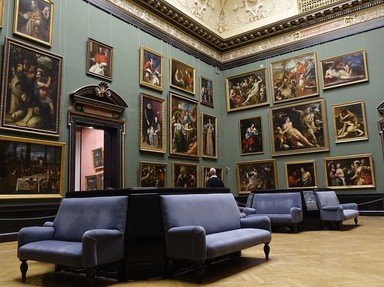Quiz Answer Key and Fun Facts
1. We ease you in gently, with one of the best-known paintings by perhaps the most famous of all Dutch artists. Painted in 1642, its official title is "The Shooting Company of Frans Banning Cocq and Willem van Ruytenburgh". Who is the artist?
2. From the sublime to the absurd, "The Threatened Swan" is a 1650 oil on canvas by a Dutch Golden Age artist who is best-known for his landscapes and animal pictures. In the late 1790s this painting was heralded as a symbol of Dutch national resistance and in 1800 it became the first acquisition of the precursor of the Rijksmuseum. Who is the artist?
3. "Morning Ride on the Beach" is an 1876 oil on canvas by a leading member of The Hague School. Noted for his depictions of people and animals in outdoor settings, particularly peasants working in the fields and various paintings of flocks of sheep. Vincent van Gogh was his cousin-in-law. Who is the artist?
4. Purchased by the Rijksmuseum in 1816, "The Merry Drinker" is a portrait dating to between 1628 and 1630. Painted by a Dutch Golden Age artist who lived and worked in Haarlem, the loose brushwork is typical of his lively style that heavily influenced Dutch portraiture in the 17th century. Who is the artist?
5. "Winter Landscape with Ice Skaters" is a spectacular 30"x52" landscape painted in 1608 by a dumb artist known as 'de Stomme van Kampen' ("the mute of Kampen"). This artist specialized in colourful and lively winter scenes, many of them depicting skaters on frozen lakes. Who is this artist?
6. The small (15"x18") "Woman in Blue Reading a Letter" dates to 1662-63. The interior scene of domestic life is typical of an artist who amazingly produced a mere 34 paintings in his lifetime. Who is this artist?
7. "Company in a Courtyard Behind a House" is a 1663 work by another master of the Dutch Golden Age. Best-known for his genre works of quiet domestic scenes (many of them interiors), he is another of those artists whose paintings have a distinctive look. Who is this artist?
8. Displayed in the 'Gallery of Honour' at the Rijksmuseum, "The Feast of St. Nicholas" is an oil on canvas dating to 1663-65. Packed with colour and lively to the point of chaos, this is typical of many works by this genre painter from the Dutch Golden Age, although he also painted historical, mythological and religious scenes, portraits, landscapes and still lifes. Who is this artist?
9. Painted sometime around 1670, "The Windmill at Wijk bij Duurstede" is a work by an artist widely considered the pre-eminent landscape painter of the Dutch Golden Age. Particularly noted for his big skies and numerous paintings of waterfalls, he was both prolific and versatile. Who is this artist?
10. The Rijksmuseum also houses a small collection of works by foreign artists. This tempera on panel, "Madonna of Humility", painted in 1440 is the work of one of the great early Italian Renaissance painters. Who is this artist?
Source: Author
EnglishJedi
This quiz was reviewed by FunTrivia editor
ponycargirl before going online.
Any errors found in FunTrivia content are routinely corrected through our feedback system.

